2009 – Brooke Crothers of CNET News states that the “PowerPC platform never lived up to the hype” and “the PowerPC platform had really failed long before 2005.” The evidence: the fact that Apple switched to Intel in 2006 and that some of the first-generation dual-processor G4 Power Macs ran hot. I beg to differ.
Competing CPUs
A long, long time ago, in a personal computing industry very different from today, Intel was just one platform among many. Until IBM embraced Intel in 1981, there was no reason to anticipate its coming dominance.
Intel
The Intel 8080 (1974) was the first successful 8-bit CPU and was used in the first personal computer, the MITS Altair 8800. This was the platform the CP/M operating system was designed for – and the Altair was the computer that Bill Gates developed the first version of Microsoft BASIC for.
The Zilog Z-80 (1976) was designed to be code-compatible with the 8080 and offered some improvements. It was popular and was most notably used in the Radio Shack TRS-80 (1977) and many CP/M machines – and today myriad Texas Instruments scientific calculators and Nintendo GameBoys are powered by Z-80 CPUs.
The 8080 was succeeded in 1977 by the Intel 8085, which required less supporting hardware and could compete with the Z-80. The next chips in the series were the 16-bit 8086 (1978) and 8088 (1980), which formed the core of the IBM PC (1981).
Thanks to that decision, the x86 architecture would go on to dominate the personal computer industry, just as Windows – a direct descendant of CP/M by way of MS-DOS – would.
Motorola
In late 1974, the Motorola 6800 was released. It was used in some kit computers, and the Motorola 6809 (1977) would go on to power the Radio Shack TRS-80 Color Computer.
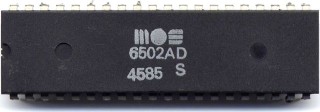 The MOS Technology 6502 (1975) was designed to be compatible with peripherals for the 6800 and became very popular – it was the least expensive CPU of its era and was used by Apple, Atari, Commodore, Acorn, and Nintendo. Although the later 16-bit 65816 made its way into the Apple IIGS, the 6502 architecture lived and died with 8-bit computing.
The MOS Technology 6502 (1975) was designed to be compatible with peripherals for the 6800 and became very popular – it was the least expensive CPU of its era and was used by Apple, Atari, Commodore, Acorn, and Nintendo. Although the later 16-bit 65816 made its way into the Apple IIGS, the 6502 architecture lived and died with 8-bit computing.
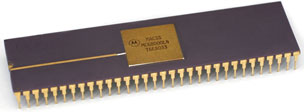 The 6800 architecture gave way to the Motorola 68000 (1980), which was one of the CPUs IBM considered for its first personal computer. The Motorola 68000 was the heart of Apple’s Lisa, the earliest Macs, the Atari ST, and the Commodore Amiga. (Interesting how the three companies most widely associated with 6502-based computers also embraced the 68000 family.)
The 6800 architecture gave way to the Motorola 68000 (1980), which was one of the CPUs IBM considered for its first personal computer. The Motorola 68000 was the heart of Apple’s Lisa, the earliest Macs, the Atari ST, and the Commodore Amiga. (Interesting how the three companies most widely associated with 6502-based computers also embraced the 68000 family.)
Later chips in this family: The 68030 would power future generations of Macs, Ataris, and Amigas, and the significantly more efficient 68040 powered Quadras and several PowerBooks. The “DragonBall” version of the 68000 chip powered Palm PDAs for several generations and is also found in some high-end TI graphing calculators.
IBM
IBM’s POWER architecture has its roots in “the 801 project” of the mid-1970s, and its design embraced the RISC (Reduced Instruction Set Computer) philosophy before it even had a name. This architecture powers all of IBM’s computers these days – and PowerPC was a branch of this CPU family.
PowerPC Origins
Tom Hormby has covered the story behind PowerPC in IBM, Apple, RISC, and the Roots of the PowerPC, so I’ll briefly summarize here.
Motorola was developing the 88000 as a RISC processor that would eventually succeed the 680×0 family, and Apple was very much involved with seeing how this could power a future generation of Apple computers. (Steve Jobs’ NeXT was also interested.)
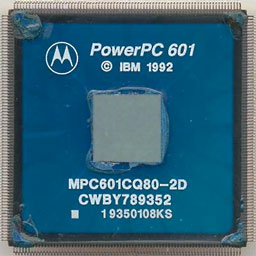 In the end, Apple convinced IBM and Motorola to work together, and the end result was the PowerPC (PPC) architecture, which merged the IBM POWER architecture with some features of the Motorola 88000. The PPC 601 (1993) was the first fruit of their labors and made its way into the IBM RS/6000 workstation in late 1993 and the first Power Macintosh computers (the 6100, 7100, and 8100) in April 1994.
In the end, Apple convinced IBM and Motorola to work together, and the end result was the PowerPC (PPC) architecture, which merged the IBM POWER architecture with some features of the Motorola 88000. The PPC 601 (1993) was the first fruit of their labors and made its way into the IBM RS/6000 workstation in late 1993 and the first Power Macintosh computers (the 6100, 7100, and 8100) in April 1994.
The later PPC 603e, a low-power chip, made its way into the first PPC PowerBooks, the 5300 and Duo 2300, and was also the heart of the dual-processor BeBox, of which only 1,800 were ever produced.
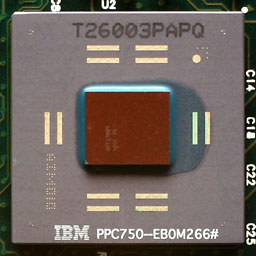 The architecture would continue its development for years to come. The G3, produced by both IBM and Motorola, powered a multitude of Macs from 1997 through 2003, the Motorola G4 became the brains of single- and dual-processor Macs from 1999 through 2005, and the IBM G5 (a.k.a. PPC 970) empowered single-, dual-, and even one quad-core Mac in the 2003 through 2005 period.
The architecture would continue its development for years to come. The G3, produced by both IBM and Motorola, powered a multitude of Macs from 1997 through 2003, the Motorola G4 became the brains of single- and dual-processor Macs from 1999 through 2005, and the IBM G5 (a.k.a. PPC 970) empowered single-, dual-, and even one quad-core Mac in the 2003 through 2005 period.
New Life for PowerPC in Gaming
More recently, the PowerPC architecture found a whole new market in game consoles.
Microsoft’s Xbox 360 (late 2005) runs a 3.2 GHz triple-core IBM “Xenon” CPU, making a complete turnabout from the x86 architecture of the original Xbox. The PPC Xenon was especially designed for the Xbox 360. Many find it ironic that Microsoft embraced PowerPC at the same time that Apple abandoned it.
The Nintendo Wii (late 2006) runs an IBM “Broadway” CPU at 729 MHz (it’s predecessor, the GameCube, released in late 2001, used a 485 MHz IBM “Gekko” CPU. It was the first popular game console to use a PowerPC chip – we can forget Apple’s failed Pippin project and the Bandai @World of the mid-1990s.)
In a perfect trifecta, PowerPC architecture also powers the third major game console, Sony’s PlayStation 3 (late 2006). In this case, the Cell processor was the joint work of IBM, Toshiba, and Sony. The Cell has one general purpose CPU core and eight specialized coprocessors (known as Synergistic Processing Elements) – an architecture inherited from the “Emotion Engine” CPU found in the PlayStation 2.
PowerPC Was a Success for Apple
Apple adopted the PowerPC architecture in 1994 and used it through 2005. Although the Mac has had incredible sales growth since the transition to Intel in 2006, the 12-year PowerPC Era also saw Apple set sales records.
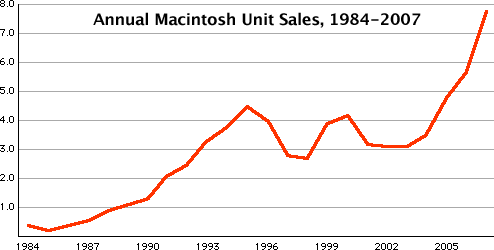
Macintosh sales during the PowerPC era (1994-2005) averaged 3.5 million units per year.
In fact, there was a strong peak in 1995, the first full year for the PPC architecture, and there was another sales spike in 1999/2000, which can be attributed to the debut of the G4, the popularity of the iMac (released mid-1998), and perhaps some switching by Windows users spooked by Y2K.
During the PPC era, Apple sold over 4 million units in 1995, 1996, 2000, and 2005 – the year it announced that it would switch the Mac to x86. And with two exceptions, Apple sold over 3 million units every year during the PPC era, only missing it by a few hundred thousand units in 1997 and 1998 – the peak of the Macintosh Clone Era. When we add in sales of Power Computing, Umax SuperMac, and Motorola StarMax models, total unit sales of Mac OS computers tops 3 million.
Apple sold approximately 42.8 million PowerPC Macs over a 12 year period. It’s true that the worldwide PC market outsold it at about 30:1 over that time (with 1.35 billion PCs), but the Mac not only survived as the lone alternative personal computing platform, under the leadership of Steve Jobs it grew to record levels and record profits.
Why the Switch to Intel?
Apple’s switch to Intel had nothing to do with the commercial viability of the PowerPC architecture. Apple could have stayed the course, continued to increase sales, and continue to grow profits. PowerPC was not a failure, as seen not only in Mac sales, but also its adoption by all three major players in the game console business.
Apple had its reasons for switching to Intel, but that’s no reason to badmouth PowerPC. Freescale (formerly Motorola’s chip division) had dual-core G4 CPUs and IBM had dual-core G5 CPUs before Apple announced its decision to go Intel. The Freescale e600 had two cores and was designed to scale past 2 GHz, which would have made it the logical successor to the 1.67 GHz single-core G4 in the fastest PowerBooks – and possibly make its way into iMacs as well. IBM uses the PowerPC 970MP (code named Antares), found in the dual-core G5 Power Macs, in its blade servers.
There was enough power in PowerPC to keep Apple viable for years to come. Architecture wasn’t the reason for the switch.
The biggest reason for going Intel was that both Motorola and IBM had let Apple down. Motorola promised the 500 MHz G4 in quantity in mid-1999, so Apple announced a 500 MHz Power Mac G4 in August 1999. They were unable to deliver it until February 2000. IBM was philosophically opposed to the AltiVec velocity engine that Motorola had developed – the key difference between the G3 and the G4. IBM managed to get the G3 up to 1.1 GHz while Motorola languished.
Apple finally prevailed upon IBM to create a CPU with a velocity engine; the result was the G5 (a.k.a. PPC 970). Apple announced the Power Mac G5 in June 2003 at 1.6 GHz to 2.0 GHz – with assurances from IBM that there would be a 3.0 GHz version within a year. It didn’t happen in a year. It didn’t happen in two years. That’s when Apple announced it would be moving the Macintosh to Intel CPUs.
Intel Advantages
The key issue is that both of Apple’s partners had let it down, not that PowerPC was a failed architecture.
That said, there were significant benefits to going with x86 architecture. Intel was putting the emphasis on computing power per watt, the very issue that had kept Apple from being able to produce a PowerBook G5. The Intel Core Duo architecture would be powerful on the desktop and energy efficient in the field.
A second benefit was that Apple would no longer have to educate people about the differences between PPC and x86 architecture. Yes, the G3 and G4 were more powerful than Intel chips, but because they ran at lower clock speeds, they were perceived by the general public as being slower. Going Intel would give Macs parity with Windows PCs.
The third benefit, and probably the most important one, was that going x86 meant that Macs would be able to run Windows. No longer would a Windows user have to switch to the Mac and leave Windows apps behind or live with horribly slow emulation. Apple’s Boot Camp software made it possible to boot Intel-based Macs directly into Windows, and virtualization software made it possible to run Windows concurrently with Mac OS X.
Windows users could embrace Macintosh hardware and become familiar with Mac OS X without ever having to completely divorce Windows. Instead of an alternative platform with no compatibility with the majority of Windows apps, the Mac became an alternative platform fully compatible with Windows. The rest is history, and it’s no surprise that Macs are selling at record levels since the Intel transition.
That said, PowerPC was a success. It lives on in blade servers and game consoles. However, x86 was a much bigger success, and Apple has been able to benefit from Intel’s expertise, economies of scale, and willingness to fabricate special versions of its chips for Apple (most notably in the MacBook Air).
Keywords: #powerpc #ppc #intelx86
Short link: http://goo.gl/DpdBCj
searchword: powerpcnotafailure

